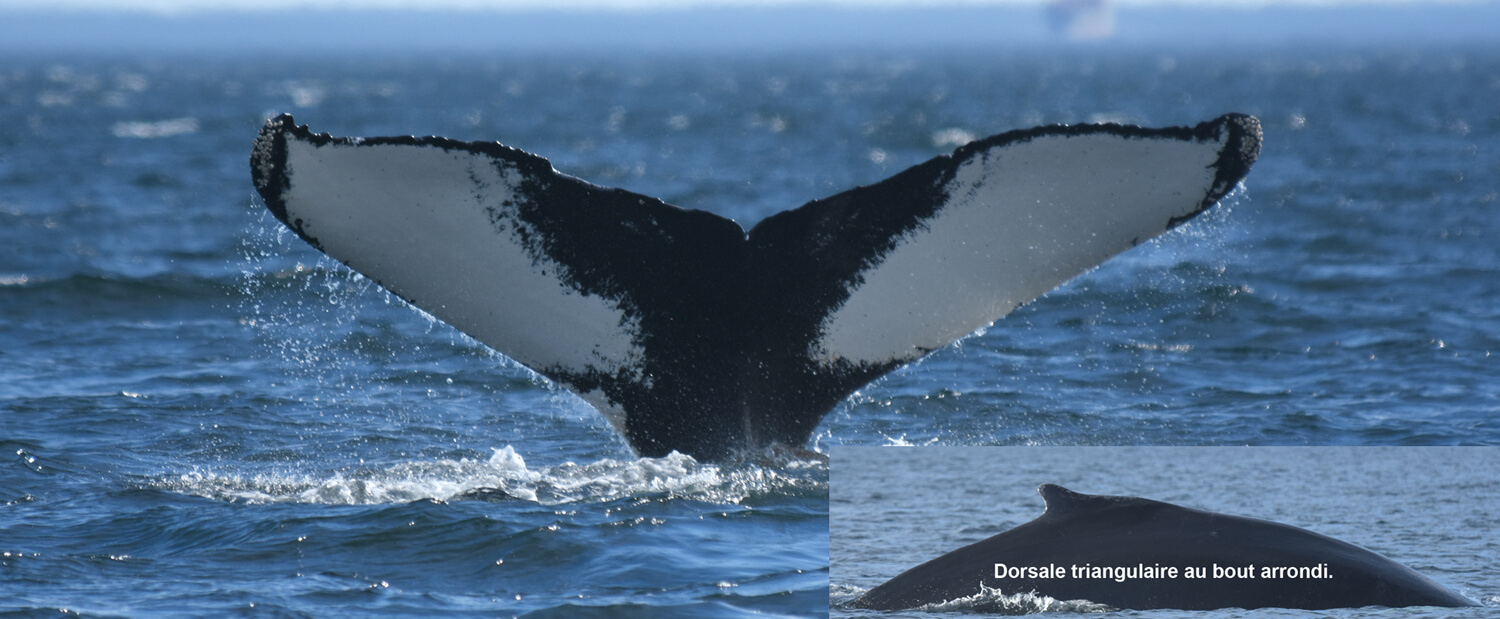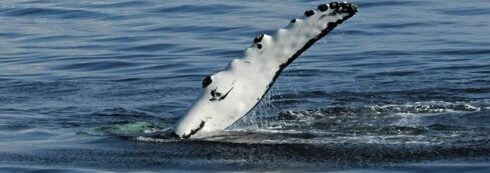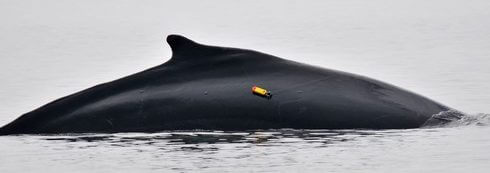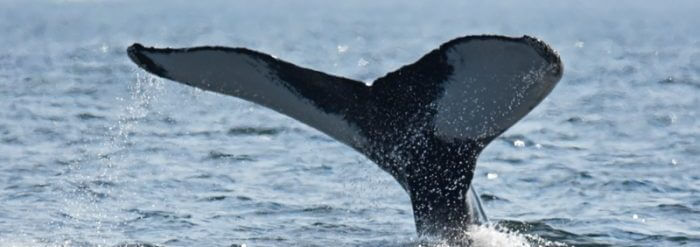Siam
Humpback Whale


-
ID number
H007
-
Sex
Male
-
Year of birth
Unknown
-
Known Since
1981
Distinctive traits
A peculiar colour pattern under the tail, where two cat eyes seem to be popping out, have earned him the name “Siam”, in reference to the well known Siamese breed of felines.
Life history
This humpback whale was the only one of its kind to travel up the St. Lawrence to Tadoussac for a long time. It came to the Estuary for short stays each year from 1981 to 1994. A great traveler, he then left for many years, frequenting the Minganie and Gaspé Peninsula. He returned to the Saguenay-St. Lawrence Marine Park in 2001. Since then, he regularly comes to make longer stays.
Siam was first photographed in 1981 by Tadoussac residents in a rowboat off Pointe à la Carriole. Since then, the Mingan Island Cetacean Research Station (MICS) team has seen him every year in the Mingan area.
In 2014, GREMM and Fisheries and Oceans Canada conducted a joint project to telemetrically track large whales. On July 15, they succeeded in attaching a tag to Siam’s back in the morning. With this tag, they were able to track the animal’s movements in the field. Despite jumping out of the water and a journey that took the team 12 miles off the Petits Escoumins River, the beacon held for 11 hours!
In 2017, researchers also took advantage of Siam’s stay in the peninsula to install a suction cup beacon on his back. This small device, combined with the use of a drone capturing aerial images, will allow scientists from MICS and the Sea Mammal Research Unit (SMRU) to learn more about the animal’s overall health.
Observations history in the Estuary
Years in which the animal was not observed Years in which the animal was observed
Latest news from the publications Portrait de baleines
A sighting of his tail fin here, a photo of his dorsal fin there: the doyen of the estuary’s humpback whales was well and truly swimming in St. Lawrence river waters on July 2! 43 years after his very first sighting in the area, Siam continues to amaze and move the scientific and whale-watching communities. And with good reason! A regular in the St. Lawrence, Siam was for a long time one of the only whales of his kind to come as far as the head of the Laurentian Channel. Other whales joined him over the years, including the famous Tic Tac Toe. Today, the increased presence of many other humpback whales reassures us of the state of the North Atlantic population, once designated “threatened”.
The story of Siam’s first sighting in the estuary reminds us that scientific history is being made every day. Aboard a fishing boat in 1981, a group sailing off Pointe à la Carriole stumbled upon a humpback whale – and what a happy coincidence it was! One of the fishermen on board pulled out a polaroid camera just in time to immortalize Siam’s fluke. It was the beginning of a long and beautiful love story between the region and this humpback whale!
With the number H007, he could have been called James Bond. But it is the Siamese cat eyes drawn on his tail that decided his name. If the arrival of this large humpback whale of at least 40 years of age creates excitement, it is because he shares a long love affair with the Estuary. First photographed in 1981 by Tadoussac fishermen off Pointe à la Carriole, Siam was for a long time the only humpback whale to venture so high into the St. Lawrence. At the time, this area was a favourite spot for fin whales and blue whales. Over the years, Siam was gradually joined by other humpback whales, such as Le Souffleur, Nasique… and even the very young Tic Tac Toe, which ventured towards Tadoussac in 1999.
At first faithful to the Estuary, Siam then went away for periods of sometimes several years, preferring the Minganie or the Gaspé Peninsula as a feeding area. Before its appearance last week, it had not been observed in the marine park since 2017. We also know that Siam was identified in winter in the Caribbean, off Puerto Rico. Logical, since it is one of the breeding grounds for humpback whales in the North Atlantic. Are descendants of the imposing Siam present in the St. Lawrence? Probably, but difficult to prove because male humpback whales do not take care of their calves… Descendants or not, Siam’s legacy remains unequaled.
After having been absent from the Estuary sector since 2012, Siam (H007) is back! He arrived in our area directly from the Gaspé Peninsula, where his presence was reported on June 29. Researchers took advantage of his visit to the peninsula to fit him with a suction-cup tag. This small device, combined with the use of a drone to capture aerial images, will enable scientists at the Mingan Island Cetacean Study (MICS) and the Sea Mammal Research Unit (SMRU) to learn more about Siam’s overall health.
This humpback has been known for a long time: the first encounter dates back to 1981, when Tadoussac fishermen photographed him off Pointe à la Carriole. Since then, his visits to our area have been somewhat sporadic, Siam preferring in certain years the Gaspé and Mingan Archipelago region over the Estuary. A peculiar colour pattern under the tail, where two cat eyes seem to be popping out, have earned him the name “Siam”, in reference to the well known Siamese breed of felines.
H007 belongs to the humpback whale population of the North Atlantic. The males of this population congregate every year in the Caribbean and sing harmonious songs as a reproductive strategy. Their vocal repertoire is fascinating: long and short segments intertwine, punctuated by silences and repetitions, all structured according to a calculated hierarchy. Researchers have attempted to dissect humpback whale serenades into “themes” that appear in a specific order, each of which seems to consist of a few repeated “phrases”, the duration of which varies between 20 and 40 seconds. Ten minutes of varied songs might pass before the humpback returns to its core “theme”.

On the other hand, a transfer of cultural heritage has been observed in some cetaceans, including humpbacks. Within each population, males conform to a specific song composed of “themes” following a specific sequence. A study conducted between 1998 and 2008 on numerous humpback whale populations in the Pacific Ocean revealed the existence of a so-called horizontal cultural transmission – either intergenerational or between individuals of the same age group without family ties – of these melodious sequences, which appears to follow an east-west trajectory.
The patriarch. This humpback was long the only member of its species to travel up the St. Lawrence as far as Tadoussac. Every year from 1981 to 1994, he would make brief incursions into the area. Subsequently, he was absent for many years, consistently frequenting the Mingan region and the Gaspé. He was seen again in the Saguenay-St. Lawrence Marine Park in 2001 and has been returning regularly ever since, and staying longer than he had in the past. This year, he arrived in the area in late June. Since then, he has been observed sometimes alone, sometimes with another humpback, whether it be Blizzard, Irisept or Aramis.
This adult male is registered in the catalogue of North Atlantic humpback whales, which comprises just over 7000 individuals. Managed by the College of the Atlantic’s Allied Whale research group, this catalogue contains photos taken by various researchers, both in the summer feeding grounds and on winter reproduction sites. According to sources, Siam has probably been identified in winter in the Caribbean, off the coast of Puerto Rico. A male like him probably makes the trip every year: 5,000 km in the fall to spend the winter singing and fighting other males in the clear southern waters in order to have the opportunity to mate with a female! In spring, he must travel 5,000 km to the cold but productive waters of the St. Lawrence in order to stock up on his fat reserves in preparation for the following reproduction season.
In 1981, it was by chance that Tadoussac residents first encountered Siam in a rowboat off the coast of Pointe à la Carriole. This is when offshore whale-watching excursions were in their infancy. This “amateur” photo would later become an invaluable piece of scientific data!




